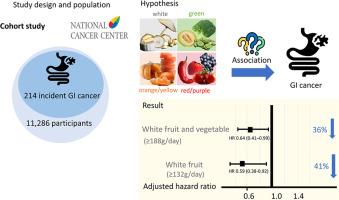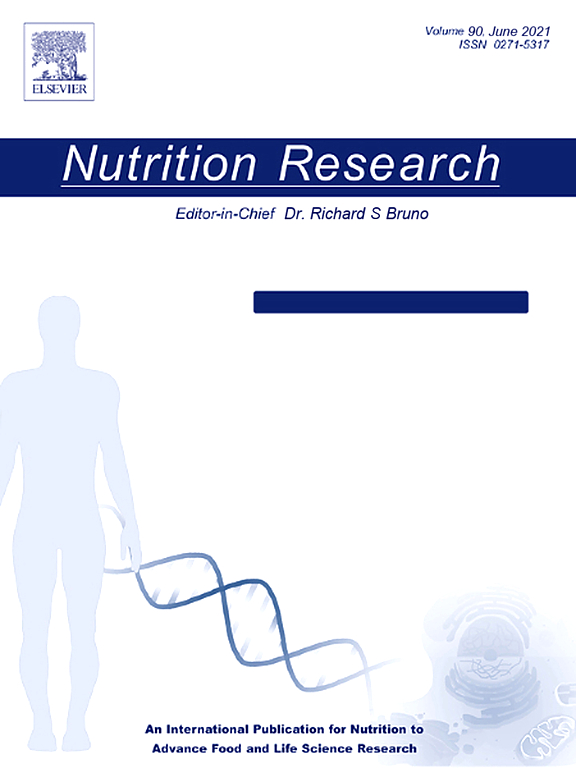A higher intake of white-edible-colored fruits and vegetables is associated with lower gastrointestinal cancer risk among Korean adults in a prospective cohort study
IF 3.1
3区 医学
Q2 NUTRITION & DIETETICS
引用次数: 0
Abstract
Although fruits and vegetables were studied botanically in previous studies, few have examined their associations with gastrointestinal (GI) cancer risk based on color classification. Color is familiar to the public and translates phytochemical science into dietary guidance. We hypothesized that the intake of fruits and vegetables would be differently associated with GI cancer risk by color. This cohort study investigated the association between fruit and vegetable colors and GI cancer risk in 11,286 participants from the Cancer Screenee Cohort, who underwent health check-ups at the National Cancer Center between 2007 and 2021. Dietary data were collected through food frequency questionnaires. A Cox proportional hazards regression model evaluated the association between fruit and vegetable color groups (green, orange/yellow, red/purple, and white) and GI cancer risk. Over a mean follow-up of 8 years, 214 GI cancers (esophageal, gastric, small intestine, liver, pancreatic, and colorectal) were identified. Higher total fruit and vegetable intake was associated with reduced GI cancer risk (hazard ratio [HR] = 0.57, 95% confidence interval [CI]: 0.38-0.88, P for trend = .013). Among color groups, white-colored fruits and vegetables (HR = 0.64, 95% CI: 0.41-0.99, P for trend = .021), and white-colored fruits (HR = 0.59, 95% CI: 0.38-0.92, P for trend = .021) were associated with a lower risk of GI cancer after fully adjusting for demographic variables, dietary factors, and comorbidities. Findings were consistent across subgroup analyses. No significant associations were found for green, orange/yellow, or red/purple groups. These results suggest that white-colored fruits and vegetables may contribute to GI cancer prevention.

在一项前瞻性队列研究中,韩国成年人摄入较多的白色可食用水果和蔬菜与较低的胃肠道癌症风险相关
虽然在以前的研究中对水果和蔬菜进行了植物学研究,但很少有人根据颜色分类来研究它们与胃肠道(GI)癌症风险的关系。颜色为公众所熟悉,并将植物化学科学转化为饮食指导。我们假设水果和蔬菜的摄入量会因颜色不同而与胃肠道癌症风险有不同的关联。这项队列研究调查了来自癌症筛查队列的11286名参与者的水果和蔬菜颜色与胃肠道癌症风险之间的关系,这些参与者在2007年至2021年期间在国家癌症中心接受了健康检查。饮食数据通过食物频率问卷收集。Cox比例风险回归模型评估了水果和蔬菜颜色组(绿色、橙色/黄色、红色/紫色和白色)与胃肠道癌症风险之间的关系。在平均8年的随访中,发现214例胃肠道肿瘤(食管癌、胃癌、小肠癌、肝癌、胰腺癌和结肠直肠癌)。较高的水果和蔬菜总摄入量与降低胃肠道癌症风险相关(风险比[HR] = 0.57, 95%可信区间[CI]: 0.38-0.88,趋势P = 0.013)。在颜色组中,在完全调整了人口统计学变量、饮食因素和合共病后,白色水果和蔬菜(HR = 0.64, 95% CI: 0.41-0.99, P为趋势= 0.021)和白色水果(HR = 0.59, 95% CI: 0.38-0.92, P为趋势= 0.021)与较低的GI癌风险相关。亚组分析结果一致。在绿色、橙色/黄色或红色/紫色组中没有发现显著的关联。这些结果表明,白色的水果和蔬菜可能有助于预防胃肠道癌症。
本文章由计算机程序翻译,如有差异,请以英文原文为准。
求助全文
约1分钟内获得全文
求助全文
来源期刊

Nutrition Research
医学-营养学
CiteScore
7.60
自引率
2.20%
发文量
107
审稿时长
58 days
期刊介绍:
Nutrition Research publishes original research articles, communications, and reviews on basic and applied nutrition. The mission of Nutrition Research is to serve as the journal for global communication of nutrition and life sciences research on diet and health. The field of nutrition sciences includes, but is not limited to, the study of nutrients during growth, reproduction, aging, health, and disease.
Articles covering basic and applied research on all aspects of nutrition sciences are encouraged, including: nutritional biochemistry and metabolism; metabolomics, nutrient gene interactions; nutrient requirements for health; nutrition and disease; digestion and absorption; nutritional anthropology; epidemiology; the influence of socioeconomic and cultural factors on nutrition of the individual and the community; the impact of nutrient intake on disease response and behavior; the consequences of nutritional deficiency on growth and development, endocrine and nervous systems, and immunity; nutrition and gut microbiota; food intolerance and allergy; nutrient drug interactions; nutrition and aging; nutrition and cancer; obesity; diabetes; and intervention programs.
 求助内容:
求助内容: 应助结果提醒方式:
应助结果提醒方式:


